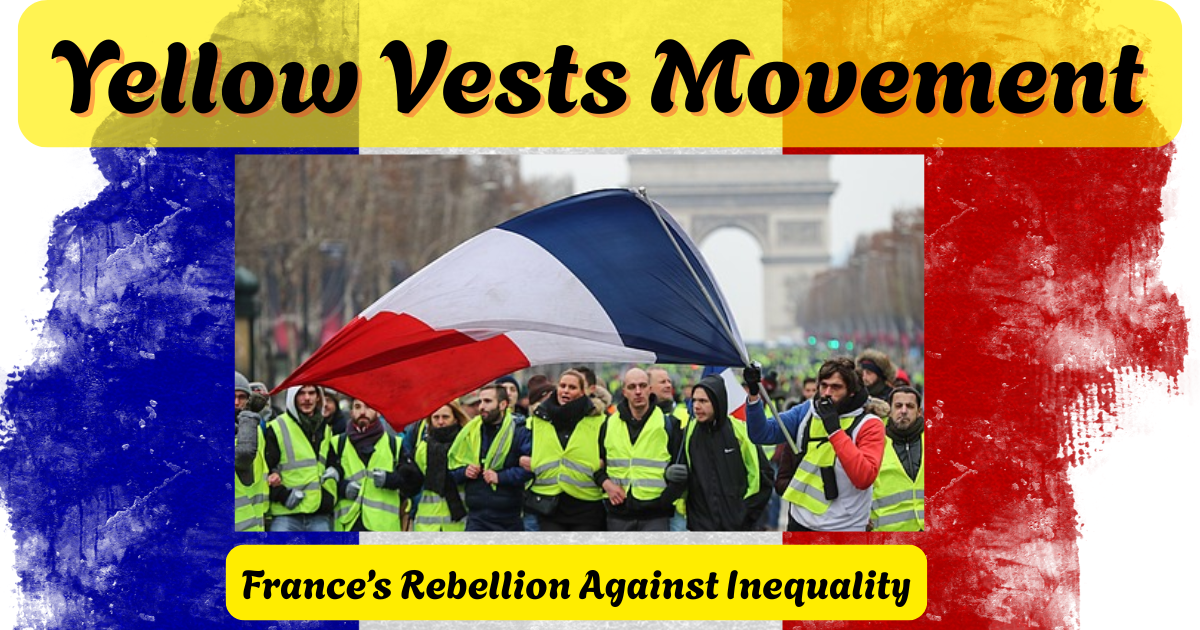Yellow Vests Movement: France’s Rebellion Against Inequality (2018–2020): The success and efficacy of social movements influencing policy changes typically originate from their reliance on garnering support from other political and social entities. The Yellow Vest Movement emerged as a response to specific grievances, initially driven by economic injustices but evolving into broader political discontent, particularly targeting the Emmanuel government.
Yellow Vests Movement
Major protests have broken out in France Over reforms implemented by successive governments in various sectors, including changes to pension schemes as well as changes to labour laws. In 2017, arriving amid economic stagnation, President Emmanuel Macron abolished the wealth tax, increased gas taxes and carried out pension reforms.

On 17 November 2018 protesters distrustful of politicians and frustrated by the rising cost of living took their grievances to the streets, calling themselves the yellow Vests after the high visibility safety vests they wear. The movement, rooted in an antielite ideology opposed to growing inequalities, spread quickly due to its leaderless organisation.
Yellow Vest demonstrators are still in the streets. Over the course of 2020. Cied Records has over 400 demonstrations affiliated with the movement. Yellow Vest demonstrators were active across all 13 regions in metropolitan France; only 10 % of demonstration events took place in the capital, Paris, and these demonstrations have occurred in villages with fewer than 1,000 inhabitants, like Glisy.
Yellow Vest demonstrators have grown frustrated with the government’s efforts to portray the movement as violent. They have often aligned themselves with other social and political movements in order to demonstrate against police violence. During June 2020, after the death of George Floyd in the United States, demonstrations over racial justice and police brutality against minorities were held across France.
The movement’s political demands have expanded as they have joined in other demonstrations. Since January 2020, Yellow Vest demonstrators have protested alongside other groups against pension reforms, police violence, coronavirus-related measures and the new security bill introduced in late 2020.
In October 2020, the government introduced a new global security bill. The articles within the proposed law sparked demonstrations. Article 21 allows police interventions to be filmed by their own mobile cameras.
The Impact of Yellow Vests Movement on French Public Policy
The success and efficacy of social movements in influencing policy changes typically originate from their reliance on garnering support from other political and social entities. In the absence of such support, sustaining mobilisation becomes challenging, often resulting in dissolution over time.
Yellow Vests Movement
The Yellow Vests Movement was a grassroots social movement consisting of regular protests that began in France on November 17, 2018, attracting nearly a million people who participated in mass demonstrations. The movement was sparked by rising fuel prices and a high cost of living, coupled with the perception of the government’s tax reforms.
A protest event analysis (PEA) of the Yellow Vest Movement
The Yellow Vest Movement emerged as a response to specific grievances, initially driven by economic injustices but evolving into broader political discontent, particularly targeting the Emmanuel Macron government. Participants in the movement varied, including students protesting education reforms, workers voicing concerns about low income and unemployment, and motorists. Initially, motorists comprised the majority of the movement. The movement peaked in November and December 2018 before undergoing a shift towards incorporating politically orientated motivations alongside its economic goals.
The Role of Public Opinion in the Policy Impact of the yellow Vests Movement
Social movements aim to raise public awareness and concern about specific issues, often mobilising individuals to influence policy processes. However, they encounter various challenges, ranging from organisational hurdles to institutional constraints. And this petition advocated for lower taxes, reduced salaries and pensions for public officials, and the implementation of citizens’ initiative referendums. The timing of the decline in public support is important for understanding its implications for both politicians and the yellow vests movement.
Conclusion
In this article we discussed the Yellow Vests Movement: France’s Rebellion Against Inequality (2018–2020): The success and efficacy of social movements influencing policy changes typically originate from their reliance on garnering support from other political and social entities. The movement was sparked by rising fuel prices and a high cost of living, coupled with the perception of the government’s tax reforms. In the absence of such support, sustaining mobilisation becomes challenging, often resulting in dissolution over time; as time progressed, fewer people and activists supported the movement.









